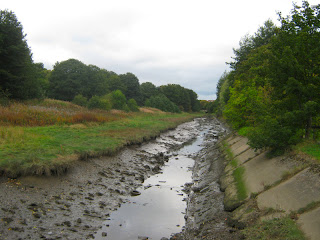Wallsend Burn trickles through Richardson Dees Park, Wallsend Civic Hall Grounds and Wallsend Burn before eventually opening out into Willington Gut, under the impressive Willngton Viaduct, before it enters the river Tyne.
5th October 2011
Willington Viaduct.
Willington Viaduct, on the North Eastern Railway, Tynemouth Branch, was ompleted for the Newcastle and North Shields Railway in 1839, by John and Benjamin Green of Newcastle. The viaduct was unusual in being of laminated timber arch construction. It has seven spans of up to 128 feet to the centers; the track height is 82 feet above the foundations. The original arches consisted of 14 layers of timber measuitng 22 feet x 3.5 feet held by trenails, the viaduct being built by Messrs Robson. The timber arches were replaced with iron in 1869, the contractors being the Weardale Iron and Coal Company.
Grade 2 Listed. Source: Sitelines.
Willington Quay Boat Club.
Willington Mill.
Willington Mill, also known as Kitty's Mill, was one of England's first steam powered flour mills. The Victorians regarded it as the most haunted building in the North of the Country. The building is now listed and is used as a canteen for the rope works along side.
More Information:
- Wikipedia - Willington Quay
- Disused Stations - Willington Quay
- Wikipedia - Willington Dene Viaduct
- Historic England - Willington Viaduct
- Co-Curate - Willington Dene Viaduct
- Chronicle Live - Willington Mill's ghostly past explored in book
- Monkchester - Willington Quay Photos
See my other photos around Wallsend:
- Wallsend Burn
- Wallsend - Burn Closes Bridge
- Wallsend - Carville Pub Fire and Demolition
- Wallsend - Church Bank Cemetery
- Wallsend High Street
- Wallsend - Holy Cross Cemetery
- Wallsend - Holy Cross Church Remains
- Wallsend - St Peters Church
- Wallsend - Swan Hunters Shipyards
- Wallsend Parks - Civic Hall and Grounds
- Wallsend Parks - The Arboretum
- Wallsend Parks - Richardson Dees Park













